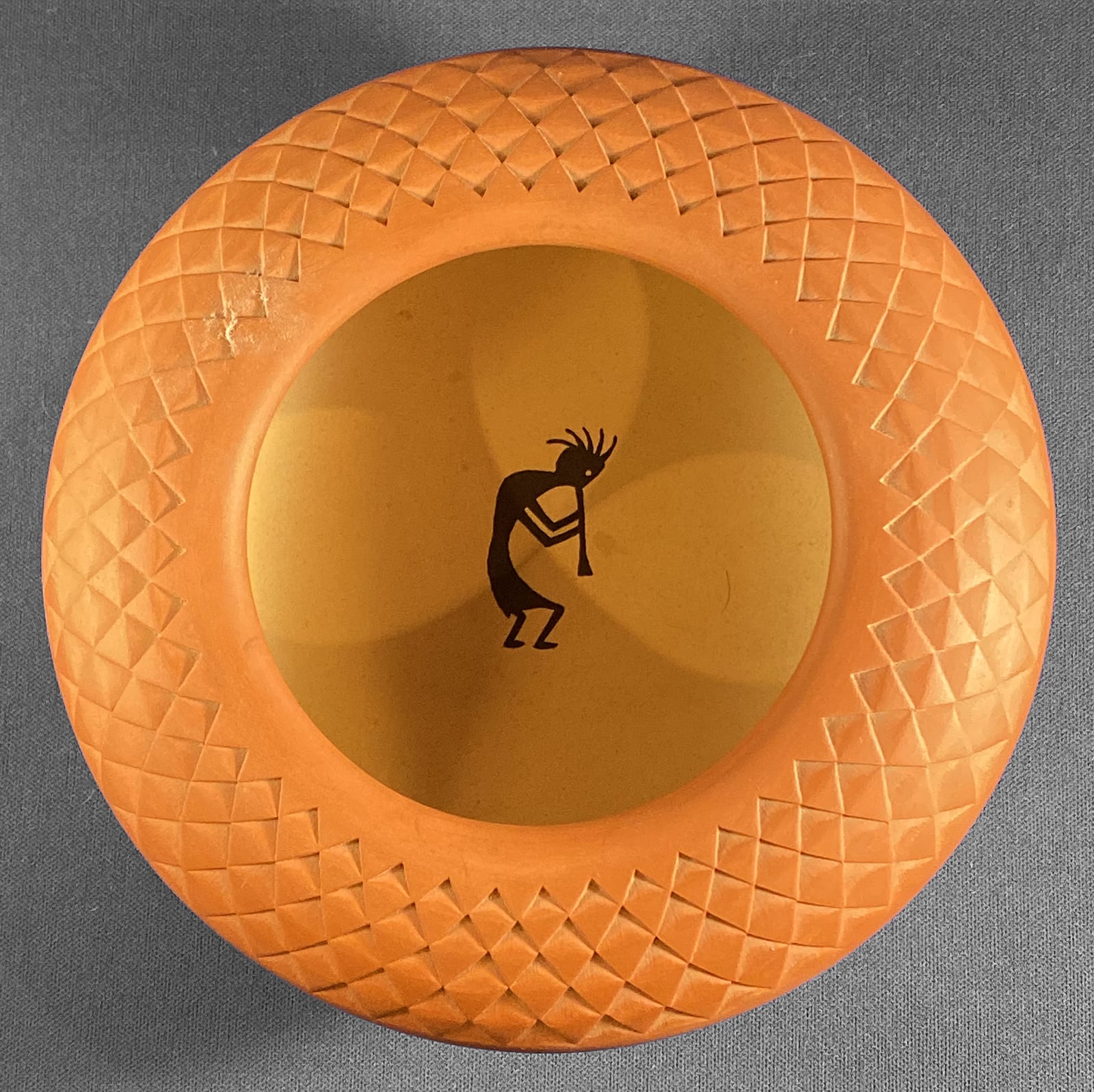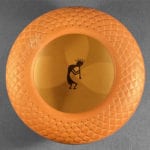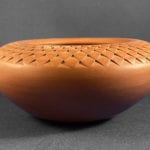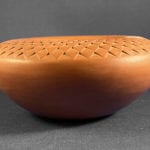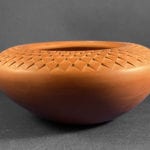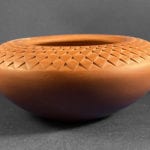After Nampeyo became functionally blind around 1920 and could no longer paint, she began to add more tactile decorations to the pottery she continued to form (Kramer, 1996:123, 153). Generally such decorations were pressed into the wet clay to give the impression of prehistoric corrugated pottery. Two such pots formed by Nampeyo are part of this collection (2012-14 and 2019-18). Hopi plainware pots with impressed designs enjoyed a minor revival in the 1970’s and 1980’s and several examples are included in this collection. Lucy Nahee (2012-17) and Priscilla Namingha Nampeyo (1993-03) made impressed pottery and more recently Bernice Addington (2004-07) continues this tradition with a patterned tool. Of all Hopi and Hopi-Tewa potters, Garnet Pavatea was best-known for her impressed pottery, which she decorated with the pointed end of a bottle opener (2012-16). The spacing of the indentations on these pots is generally casual and irregular, though the pot by Bernice Addington is an exception.
Seedpot 2019-14 by Preston Duwyenie is the most carefully decorated impressed pot I have ever seen. The result is serene.
The bottom and walls of seedpot 2019-14 are fairly thick, the sloped top somewhat thinner, as is generally the case. These walls are even and the junction between the sides and top of the jar is seamless.
For reasons unknown to me, modern impressed Hopi pots all have a red exterior surface. Perhaps the even red color of the fired clay highlights the impressions more than the more common grey clay that may fire with an unevenly blushed cream-to-gold color. But this is just a guess. The four modern pots referenced above are formed of yellow clay that fires red. Pot 2019-14 has the expected red exterior but has a pale tan interior. Looking at the pot I could not tell if red exterior was because the body of the pot was formed from the sikyatska clay with an interior tan slip or the reverse: a tan clay body with an external red slip. About a year after purchasing this pot (8-18-20) I had a chance to speak with Preston. He told me the body of this jar is formed from clay that fires red and comes from his grandmother’s clay pit at Hotevilla. “I remember the pot that you have, it was made in the late 70’s/early 80’s, can’t remember the exact timeline,” he said.
The lower half of the pot is undecorated and shows striations that encircle the body parallel to the bottom. I’m not sure if these marks indicate the direction of stone polishing or the slightly irregular application of a red slip, if the pot is slipped.
When tapped with a finger, the pot emits a dull “thunk,” which may indicate it was fired at a low temperature in an outdoor fire but on the other hand was fired at IAIA where a kiln firing is more probable. Preston now fires exclusively in a kiln “because I look a clean look and don’t want firing clouds” he told me during our August 2020 phone conversation.
The design is made of interlocking diamond-shaped forms. Technically this is “tessellation,” the filling of a plane using geometric shapes (“tiles”), with no overlaps and no gaps. Here the tiles are diamond forms, each divided at its horizontal waist into an upper and lower triangular section. The upper triangle is indented below the original polished surface of the jar. The lower triangular section of the diamond is he original surface. A narrow unmarked band surrounds the lip of the seedpot, its outer edge a fringe of 44 small triangles that are defined by 43 small impressed triangles that flank them. The base of each impressed triangle forms the upper half of the first circle of diamond forms. This first row of diamonds is a bit smaller than the next, with each succeeding row a bit larger than the last since the top of the jar increases in circumference as it moves from the lip to the edge.
So perfectly shaped and placed are the diamond forms that the design plays tricks with a viewer’s eyes. With the eyes sweeping from the central ring of diamonds to the outer ring moving left, each set of four neighboring diamonds form curved rows flowing to the left, a ribbon of design. With the eyes refocused and sweeping from the center of the design to the edge moving right, the viewer sees curved ribbons of design flowing right. These forms can also be viewed flowing perpendicular from the pot’s lip to the outer edge of the top surface, and from this perspective the design forms a series of steps up to the central opening.
Thus each diamond form shifts its association with its neighboring form depending on how the seedpot is observed. The three contrasting patterns of association between the diamonds gives the pot a subtle energy. The overall impression of the design is one of balance and simple Zen-like serenity. Much of these effects may be subliminal, but people look and smile. Such shifting visual patterns are characteristic of tessellation.
The light tan color of the interior lightens the appearance of the seedjar and highlights the external design. Only when the pot is seen directly from above is a painted black image of Kokopelli seen on the interior, an added bonus like an after-dinner mint.
The pot is lightly signed “Duwyenie” on the bottom, though the last few letters are faded. More recently Preston does not spell his name on a pot’s bottom, but instead used a hallmark: “What is depicted is an image of a woman carrying a child on her back,” Preston writes on his website, this “is a translation go my Hopi name Loma-i-quil-va-a, ‘Carried in Beauty,” the name given to me by my Grandmother following my initiation.” For a more recent pot with this hallmark, see 2020-19.
Born in 1951 to the Reed Clan at Hotevilla (Third Mesa), Preston received an Associate’s degree from the Institute of American Indian Arts (IAIA) in Santa Fe where he studied pottery with Otellie Loloma, among others. Later, he received a Bachelors in Fine Arts from Colorado State University. This formal training in the arts is probably what distinguishes his precise style from the more casual, folk art tradition of others who have made impressed pottery. Pot 2019-14 is an early pot by Preston and may have been made while he was a student. In an email to me on 8-17-20, Preston wrote of this pot: “I remember the pot that you have, it was made in the late 70’s/early 80’s, can’t remember the exact timeline.” Later, in a phone conversation, he noted that he was a student at IAIA when he made this pot. He returned to IAIA for six years as an instructor and now lives in Santa Clara Pueblo. Most of his recent work uses micaceous clay gathered near Santa Clara, is kiln- fired, and includes precisely-cast silver medallions, giving his pottery a unique look. He has won numerous awards for pottery, including “Best of Show” at the Heard Indian Market.
I attended the first SWIA “Winter Market,” in December 1988, perhaps. I am not sure of the year. Very few people attended the event and Preston gave a workshop on pottery making to me and one other collector. I was impressed by both his knowledge and his quiet demure. Such character, it seems to me, is reflected in pot 2019-14.

